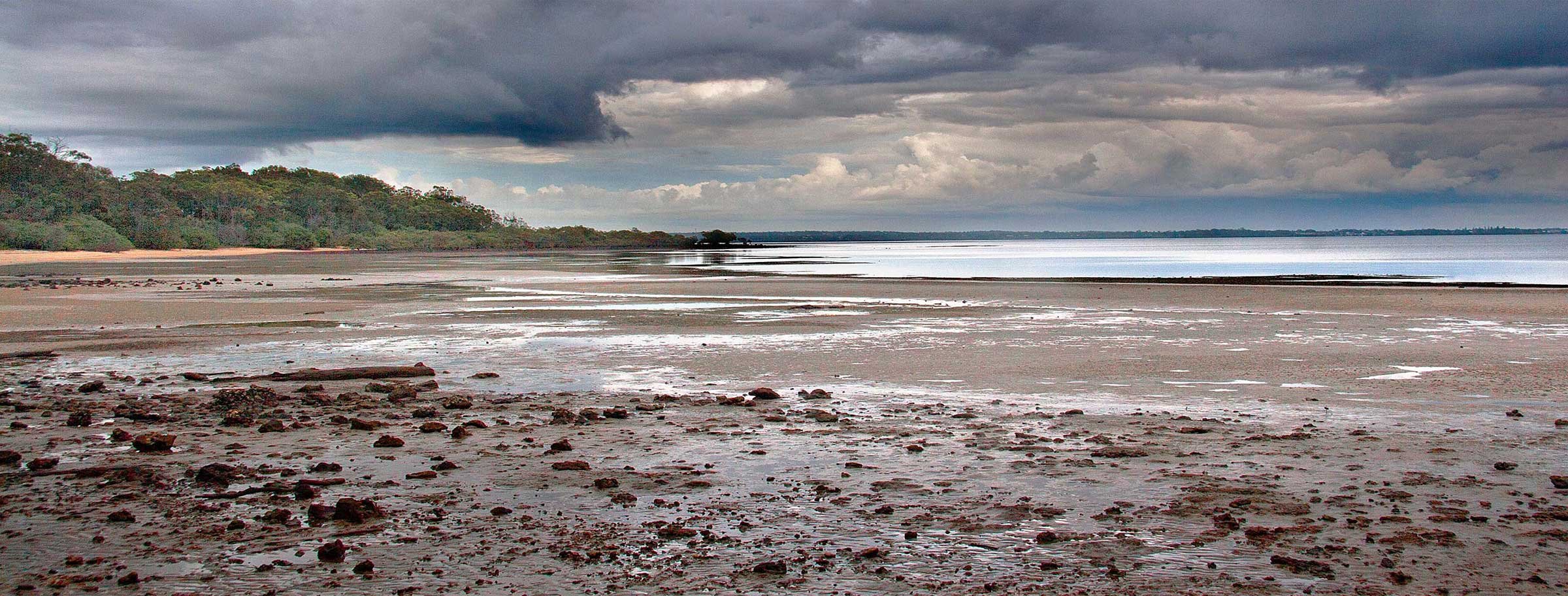
Shorebirds
on Coochiemudlo Island
By Peter Wear
Photography by Peter Wear and Chris Walker.
Please, never approach any birds feeding on the mudflats, or allow a dog in their vicinity.
Shorebirds depend on, for their very survival, undisturbed access to these sites at low tide.
Coochiemudlo Island is in Moreton Bay Marine Park, which stretches from Caloundra down to the Gold Coast. The Park is home to over 35,000 migratory shorebirds. A smaller number of Moreton Bay’s shorebirds, about 3,500, are resident all year round.
What defines a shorebird?
Shorebirds are in the order Charadriiformes. Other birds that you might see on the shoreline at low tide, like egrets and herons, are in a different scientific order of classification.
Shorebirds feed almost exclusively on the narrow strip of shoreline between high and low tide. That’s why they’re so vulnerable to any disturbance that sends them skywards during the critical hours when the tide is out.
Shorebirds can only forage twice a day, in the hours when the low tide exposes the mud and rocks where they dig for worms, crustacea and the other sea-life that sustains them.
Being ground feeders that also rest and lay their eggs on the ground, shorebirds are wary and quick to flee from disturbance. As our bayside beaches become ever more popular, and jetskis and dogs proliferate, it’s crucial we preserve the known sites that give our shorebirds birds the security they need to roost, raise their chicks, and feed. That’s one reason why dogs are prohibited at all times on Coochiemudlo’s beaches. The exception is a dedicated, but seasonal, off-leash area west of the barge ramp.
Migratory shorebirds on Coochiemudlo Island
Migratory shorebirds feed up over the summer months in preparation for the long perilous flight to their breeding grounds in the Arctic. Coochiemudlo is often visited by migratory shorebirds like the Far Eastern Curlew and the Whimbrel.
Far Eastern Curlew
Far Eastern Curlew. Photo by Chris Walker.
The Far Eastern Curlew Numenius madagascariensis is the largest Australian shorebird and is Critically Endangered. Its numbers have fallen by about 80% over the last 30 years. They are very timid and feed far out on the edge of very low tides, or on the sand bars west of the island. A greater number forage close to the dense mangroves along Coochiemudlo’s western shore. All these curlews probably fly over to the island from nearby roosting sites on the mainland.
Whimbrel
Whimbrel. Photo by Chris Walker.
The Whimbrel Numenius phaeopus is similar in appearance to the Far Eastern Curlew, but smaller with a shorter beak. Whimbrels can be seen on the sand flats near Coochiemudlo’s south-west corner, and foraging out beyond the rocks at the northern end of Norfolk Beach. As Whimbrels are known to roost in mangroves, they may be resident in the mangrove forest along the island’s western side.
Resident shorebirds on Coochiemudlo Island
Species such as Masked Lapwings and Pied Oystercatchers roost on Coochiemudlo’s Emerald Fringe, and forage off our beaches when the tide is out. You might also see Beach Stone Curlews on the sand or out on the mudflats, but they’re timid and easily frightened into flight by human disturbance, and especially by dogs.
Masked Lapwing
Masked Lapwing. Photo by Peter Wear.
The Masked Lapwing Vanellus miles is tolerant of human presence and fiercely defensive of their young. They roost on the Emerald Fringe behind Morwong Beach and are frequently seen on the mudflats. They also forage on the edge of incoming tides on Norfolk Beach. Their temperament, and ability to feed on dry land as well as wet, make them a common sight around the island beaches.
Pied Oystercatcher
Pied Oystercatchers. Photo by Peter Wear.
Pied Oystercatcher Haematopus longirostris — There used to be two pairs of oystercatchers on Norfolk Beach. Now, only this pair remains. They are rated as Vulnerable in Queensland, Endangered in NSW. Oystercatchers are very site loyal, laying their eggs over summer in a scrape above high water. Unusually, chicks are fed by their parents. They break up crabs and poke them into the young bird’s bill.
Beach Stone-Curlew
Beach Stone-Curlew. Photo by Peter Wear.
Beach Stone-Curlew Esacus magnirostris – These curlews are now considered Rare, with a likely Australian population of just a few thousand. A pair on Coochiemudlo divide their time between the golf course shoreline and the rocky north-east outcrop at the end of Norfolk Beach. It’s larger than the island’s common Bush Stone-Curlews, with a thicker short beak that it uses to break open shells and crabs. It nests in a shallow scrape just above high tide where, usually, one egg is laid.
Birds that share the mudflats with shorebirds
Shorebirds share the mudflats with other occasional visitors that stop by for seafood. Here are four common species — that aren’t shorebirds — often seen on the extensive mudflats off Morwong Beach.
Great egret Ardea alba. Photo by Chris Walker.
White-faced Heron Egretta novaehollandiae.
Photo by Chris Walker.
Royal Spoonbill Platalea regia
Photo by Peter Wear.
Australian White Ibis Threskiornis molucca
Photo by Chris Walker.
Ibis eat insects, spiders, worms, snails, frogs and even small mammals and cane toads. It will polish off unattended food on tables or plates, and dig in bins for scraps. On the mudflats you’ll see them foraging for crabs and molluscs. They roost in large numbers in high trees. The Melaleuca wetlands has a big ibis roost which produces a lot of honking around sundown.









